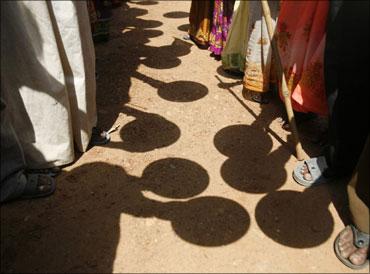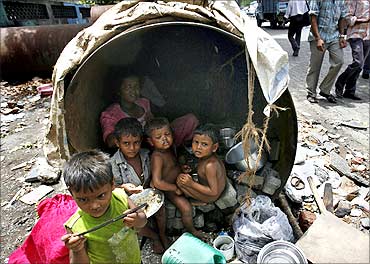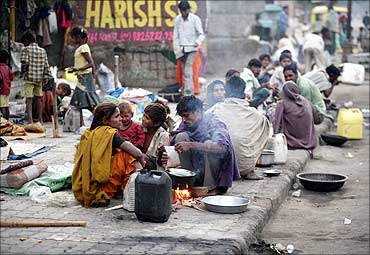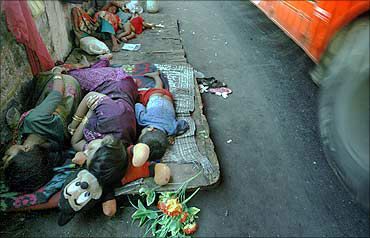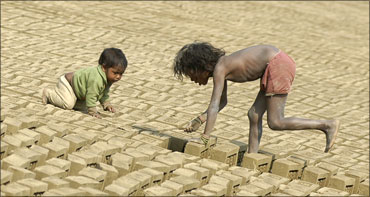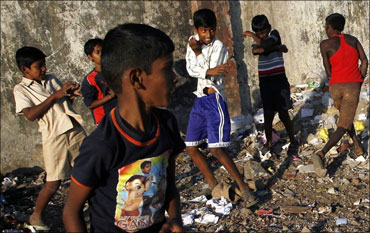 | « Back to article | Print this article |
Rs 26 a day! Garibi Hatao in the Congress-BJP way
In the aftermath of a controversial affidavit by the Planning Commission in the Supreme Court, it is useful to remind its authors of the premise of the first Human Development Report of 1990 that 'people are the real wealth of a nation'.
The UN Declaration of Alma-Ata on Primary Health Care, 1978, also argued for 'promotion of food supply and proper nutrition'.
The world's premier intelligence agency will have us believe that 'rich nations generally employ more generous standards of poverty than poor nations' disregarding the fact that one in six American citizens are living in poverty: the highest poverty rate in the United States since 1983.
According to the US census, its poverty rate rose to 4.6 crore (46 million) people in a population of 31 crore (310 million).
Click NEXT to read on . . .
Rs 26 a day! Garibi Hatao in the Congress-BJP way
The question is how to genuinely assess the felt needs of citizens who are below a decent way of living, based on their consumption of food and arrangement for housing.
Before that there is a need to ponder over what comes first: poverty alleviation or financial wealth generating economic activity in an 'open-market economy'? The Planning Commission has been putting the cart before the horse for quite a while.
In an affidavit filed by B D Virdi, adviser, Planning Commission, before the Supreme Court in the PUCL versus Union of India & Others or Writ Petition (Civil) 196 of 2001, the Commission said that any citizen who spends more than Rs 965 per month in urban India (around Rs 32 per day) and Rs 781 in rural India (around Rs 26 per day) 'at June 2011 price level' would be considered not to be poor.
This has set a poverty line based on the monetary value of some normative expenditure that is deemed essential.
Click NEXT to read on . . .
Rs 26 a day! Garibi Hatao in the Congress-BJP way
As per the Tendulkar Committee, the total Below Poverty Line population in India was 40.74 crore (407.4 million) in March 2005. It is highly insensitive on the Virdi's part to suggest that 'the total BPL population as per 2009-10 estimation may be lower' than that what emerges from Tendulkar Committee's projection.
The world over, rise in food prices increases poverty but this insincere affidavit states the contrary.
The affidavit submits that 'at June 2011 price level, for a family of five this provisional poverty line would amount to Rs 4,824 per month in urban areas and Rs 3,905 per month in rural areas. However, final poverty lines following the Tendulkar Committee will only be available after completion of the 2011-12 NSS Survey' by National Sample Survey Organisation (NSSO).
Till then, the poor can wait. Meanwhile, 'The poverty estimates for 2009-10 are being worked out on the basis of the detailed NSSO data which has become available'.
Click NEXT to read on . . .
Rs 26 a day! Garibi Hatao in the Congress-BJP way
While hearing the PUCL case on September 20, 2011, the Bench of Justice Dalveer Bhandari and Justice Deepak Verma ordered, 'We direct the States and Union Territories to inform the public about the availability of the night shelters through print media and electronic media, so that the poor and needy people may avail the benefit of the night shelters.'
Clearly, Rs 26 per day for rural India and Rs 32 for urban India is not sufficient to ensure housing for the poor. As to urban India, the Committee on Slum Statistics/Census under the Ministry of Housing and Urban Poverty Alleviation has projected the slum population to be 9.3 crore (93 million) as of March 2011, which was 5.23 crore (52.3 million) in 2001.
In the order dated May 14, 2011, the Apex Court observed, 'We see no rationale in not distributing food grains according to the estimate of Union of India. The food allocation should be based on every year's population estimate as carried out by the Planning Commission or the Registrar General, in the absence of any official census figure.'
This order of the Apex Court has to be implemented in the 35 States and Union Territories, 640 districts, 5,924 sub-districts, 7,935 towns and 640,867 villages.
Click NEXT to read on . . .
Rs 26 a day! Garibi Hatao in the Congress-BJP way
As per Census 2011, the provisional population of India is 121 crore (1.21 billion). But there is nothing on record to show that the Indian National Congress-led government has complied with the court's order so far.
The matter will come for further directions on November 2, 2011.
The National Commission for Enterprises in the Unorganised Sector headed by Arjun Sengupta found in its report on 'Conditions of Work and Promotion of Livelihoods in the Unorganized Sector' at the end of 2004-05 that 77 per cent Indians, or 83.6 crore (836 million) citizens, lived on less than Rs 20 per day.
But the United States' Central Intelligence Agency says that as per 2007 estimates 25 per cent of India's population is below poverty line. Its website mentions this figure as of August 29, 2011.
Click NEXT to read on . . .
Rs 26 a day! Garibi Hatao in the Congress-BJP way
The 39-page report of the expert group to review the methodology for estimation of poverty authored by Suresh Tendulkar, R Radhakrishna and Suranjan Sengupta for the Planning Commission in November 2009 left the all-India urban poverty estimate unaltered at 25.7 per cent.
It has revised the estimate of poverty in India for 2004-05 to 37.2 per cent from 27.5 per cent, and for rural India to 41.8 per cent. Its estimation was based on consumption share of commodities around poverty line class for urban areas in all India.
The commodities included consumption of cereal, pulses, milk, edible oil, meat products, vegetables, fresh fruits, dry fruits, sugar, salt, spices, fuel, clothing, footwear, education, medical, entertainment, rent, footwear and conveyance.
Taking note of the above, the Apex Court, vide its order dated May 14, 2011, directed that: 'According to the Tendulkar Committee, with the price level of 2011, it is impossible for an individual in an urban area to consume 2,100 calories in Rs 20 and an individual in a rural area to consume 2,400 calories at Rs.15. The Planning Commission may revise norms of per capita amount looking to the price index of May 2011 or any other subsequent dates.'
Click NEXT to read on . . .
Rs 26 a day! Garibi Hatao in the Congress-BJP way
This appears to be an indictment of the Plan panel which should be sufficient reason for the concerned officials to step down or recuse themselves from such work in future.
The Planning Commission's affidavit stating 'the Poverty Lines recommended by Tendulkar Committee are not anchored in calorie intake norm' seems to be defending the indefensible.
It appears relevant to recollect the historical context of planning process in India. In 1887, A O Hume the founder of Indian National Congress, addressed the dull misery of the starving residents of India saying, "Toil, toil, toil; hunger, hunger, hunger, sickness, suffering, sorrow; these alas, alas, alas are the keynotes of their short and sad existence," in a pamphlet at the Madras Session.
Things remain the same even today. Later, speaking on behalf of the party, Mahatma Gandhi had said, 'Above all, the Congress represents, in its essence, the dumb, semi-starved millions scattered over the length and breadth of the land in its 700,000 villages' at the Second Round Table Conference in 1931 in London.
Click NEXT to read on . . .
Rs 26 a day! Garibi Hatao in the Congress-BJP way
This party cannot claim to represent the starving millions after the affidavit filed on behalf of its prime minister.
In order to address hunger and starvation among other issues, in October 1938, Subhas Chandra Bose formed the National Planning Committee in his capacity as the president of Indian National Congress just around the time World War II broke out. This committee functioned till 1949 with its sub-committees and made several valuable recommendations under Jawaharlal Nehru's chairmanship.
Later, following a resolution of Congress Working Committee in January 1950 that recommended setting up of a statutory body for planning and its announcement in the Union Budget of February 1950, the Planning Commission was set up by a resolution of Government of India dated March 15, 1950.
Those were war-time efforts. There is now a need for peace time efforts for genuine democratic planning.
Click NEXT to read on . . .
Rs 26 a day! Garibi Hatao in the Congress-BJP way
The Supreme Court is compelled to act because there is rampant hunger, starvation and malnutrition in the country which has not been addressed by two national political parties who have been dishonest to their party constitution.
As per Article I and II of the Constitution of the Indian National Congress, Manmohan Singh is a socialist first and the chairman of the Planning Commission later.
This is true about Bharatiya Janta Party as well because Article II of its Constitution pledges allegiance to socialism. The registration document of the party also reveals its ideology as Gandhian Socialism.
It has been argued by Yashwant Sinha, former finance minister, that the "Planning Commission is the nodal agency for estimating poverty along with the Ministry of Rural Development, Ministry of Housing and Urban Poverty Alleviation, NSSO under the Ministry of Statistics and Program Implementation, Registrar General of Census under the Ministry of Home Affairs and now the Unique Identification Authority of India housed in the Planning Commission." Sinha is also a socialist as per his party's constitution.
Click NEXT to read on . . .
Rs 26 a day! Garibi Hatao in the Congress-BJP way
With its repeated failure to address the gnawing felt needs of the poor in the country, the Planning Commission stands exposed. Its scandalous recommendations create a compelling logic to disband the commission.
This can initiate the planning process as envisaged in the Constitution under Eleventh Schedule (Article 243-G) for rural local government and under Twelfth Schedule (Article 243-W) for urban local government for reaching the unreached malnourished compatriots unmindful of whether or not one agrees with CIA's assessment of India "developing into an open-market economy" with "traces of its past autarkic policies".
The fact remains that almost every act of the Planning Commission echoes the above assessment despite stark poverty in the USA.
"What is important is that the food must reach the hungry," observed Supreme Court of India on August 20, 2011. Will all the opposition parties, including the Left and regional parties, act together to ensure that?
